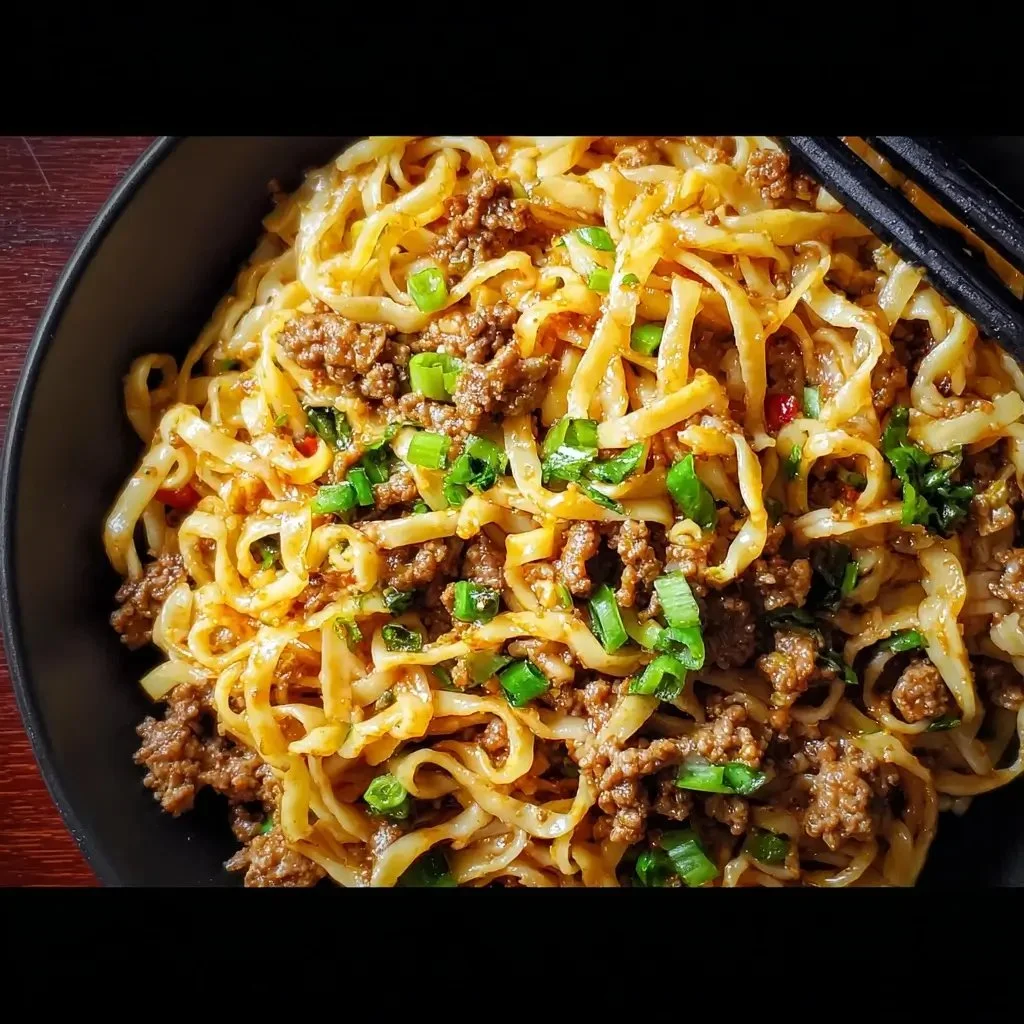why make this recipe
Asian Ground Beef Noodles are a quick and delicious meal that combines savory flavors with the satisfying texture of noodles. This recipe is not only easy to prepare but also versatile, allowing for changes based on your taste and available ingredients. It’s perfect for weeknight dinners or when you want to impress guests without spending hours in the kitchen.
how to make Asian Ground Beef Noodles
Ingredients:
- 1/2 cup Low-Sodium Soy Sauce: This is the salty, umami backbone of our sauce. Using low-sodium gives you more control over the final saltiness, as the beef broth will also add sodium. You can always add more, but you can’t take it away.
- 1/4 cup Beef Broth: This adds a rich, meaty depth to the sauce that water alone cannot provide. It thins the sauce to the perfect consistency for coating the noodles.
- 2 tablespoons Brown Sugar, packed: This provides the essential sweetness to balance the salty soy sauce. You can substitute with honey or maple syrup if you prefer, though brown sugar lends a wonderful molasses note.
- 1 tablespoon Toasted Sesame Oil: A little goes a long way! This isn’t a cooking oil but a finishing oil, prized for its intense, nutty, and aromatic flavor. It’s a non-negotiable ingredient for that authentic Asian flavor profile.
- 1 tablespoon Rice Vinegar: This touch of acidity is crucial. It brightens up all the other flavors and cuts through the richness, preventing the sauce from feeling too heavy.
- 1 tablespoon Sriracha or Gochujang (optional): For those who like a bit of heat. Sriracha provides a straightforward garlic-chili kick, while Gochujang (a Korean chili paste) offers a more complex, slightly sweet and funky spiciness. Adjust the amount to your personal spice preference.
- 1 tablespoon Cornstarch: This is our thickening agent. When mixed with a little cold water to create a slurry, it will transform the liquid sauce into a glossy, velvety coating that clings beautifully to the beef and noodles.
- 1 lb (450g) Lean Ground Beef: We recommend using an 85/15 or 90/10 lean-to-fat ratio. This provides enough fat for flavor and moisture without making the final dish greasy.
- 1 lb (450g) Noodles: The beauty of this recipe is its versatility with noodles. Classic choices include ramen noodles (discard the seasoning packet), udon noodles, or even spaghetti or linguine in a pinch.
- 1 tablespoon Avocado Oil or other neutral, high-heat oil: Used for sautéing the aromatics and browning the beef. Avocado, canola, or grapeseed oil are excellent choices because of their high smoke points.
- 4 cloves Garlic, minced: Fresh garlic is essential. Its pungent, aromatic quality is a cornerstone of the dish’s flavor. Don’t be tempted to use garlic powder here; the flavor of fresh is unparalleled.
- 1 tablespoon Fresh Ginger, grated: Like garlic, fresh ginger provides a warm, zesty spice that pre-ground versions can’t replicate. Use a microplane or the fine side of a box grater for the best results.
- 1 bunch Green Onions, sliced: Use these in two ways. Sauté the white and light green parts for flavor and use the dark green tops for garnish.
- 1/2 cup Shredded Carrots (optional): An easy way to add a vegetable, a pop of color, and a subtle sweetness to the dish.
- For Garnish (optional but highly recommended): Toasted sesame seeds, chopped cilantro, extra sliced green onions, red pepper flakes.
Directions:
- In a medium-sized bowl or a liquid measuring cup, combine all the sauce ingredients: low-sodium soy sauce, beef broth, brown sugar, toasted sesame oil, rice vinegar, and sriracha (if using). Whisk until the brown sugar is completely dissolved. Set this mixture aside near your stove.
- In a small bowl, mix the cornstarch with cold water until smooth. Set this aside as well.
- Bring a large pot of salted water to a boil. Cook your chosen noodles according to the package directions until they are al dente. Drain and rinse them with cold water to stop the cooking process. Set aside.
- Heat a large skillet over medium-high heat and add the avocado oil. Once hot, add the minced garlic, grated ginger, and white and light green parts of the green onions. Stir-fry for 30-60 seconds until fragrant.
- Add the ground beef to the skillet and cook until browned. This should take about 5-7 minutes. If you notice excess grease, remove some of it, leaving about a tablespoon.
- Pour the sauce mixture into the skillet and bring it to a simmer, stirring to coat the beef.
- Stir the cornstarch slurry again and pour it into the pan. Keep stirring until the sauce thickens and becomes glossy, usually within 1-2 minutes.
- Add the cooked noodles and shredded carrots (if using) to the skillet. Toss everything together until the noodles are well coated.
- Remove from heat and serve hot.
how to serve Asian Ground Beef Noodles
Serve the Asian Ground Beef Noodles hot from the skillet. You can garnish with toasted sesame seeds, chopped cilantro, sliced green onions, or a sprinkle of red pepper flakes for an extra kick. Pair it with a side of steamed vegetables or a simple salad for a complete meal.
how to store Asian Ground Beef Noodles
To store leftovers, let the noodles cool completely, then transfer them to an airtight container. They can be kept in the refrigerator for 3-4 days. To reheat, add a splash of water or broth to the noodles in a pan and warm them over medium heat, stirring until heated through.
tips to make Asian Ground Beef Noodles
- Use high-quality ingredients for the best flavor, especially the soy sauce and sesame oil.
- Feel free to add more vegetables like bell peppers, snap peas, or spinach to increase the nutrition.
- Adjust the spice level by adding more or less Sriracha or Gochujang.
- If you don’t have cornstarch, you can use all-purpose flour as a thickener.
variation
You can easily switch out the lean ground beef for ground turkey, chicken, or even tofu for a vegetarian option. Experiment with different noodles or add more vegetables to customize the dish to your liking.
FAQs
-
Can I use a different type of noodle?
Yes! This recipe works well with various noodle types like rice noodles, udon, or even spaghetti if that’s what you have. -
How spicy is this dish?
The spice level depends on your choice of Sriracha or Gochujang. You can omit it entirely for a milder dish. -
Can I make this recipe in advance?
Yes, you can prepare the components separately ahead of time and combine them just before serving for the best texture.

